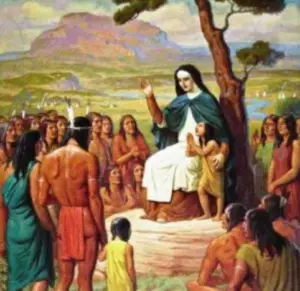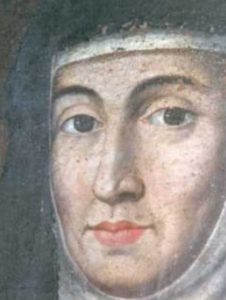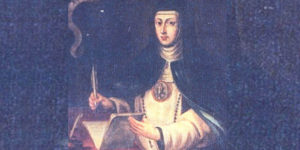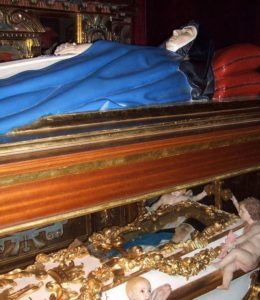Podcast: Play in new window | Download
Subscribe: Apple Podcasts | RSS
 The year was 1626 and the place was the northern fringes of the Spanish Empire in the New World. A group of several dozen Jumano Indians arrived at the mission of San Agustín de la Isleta located about 13 miles south of modern-day Albuquerque, New Mexico. Curiously, the Indians were carrying crosses and asked to speak with the Custos, or head, of the newly established Franciscan missions. The head of the missions was the middle-aged Portuguese friar Afonso de Benavides also known by his Spanish name, Alonso de Benavides. The Custos knew that the Indians before him were not from the local pueblos. The leader of the group described their long trek of hundreds of miles from the Big Bend area of Texas to the Isleta mission. When asked why they had traveled so far and why they were carrying the crosses, the leader explained that they had been instructed to do so by a young woman wearing a blue robe who had appeared to them several times over the past year. The “Lady in Blue” apparently instructed the Jumano group in the basics of Christianity and told them to seek out the help and protection of the missionaries. Benavides was impressed with the Indians’ knowledge of Catholic rites and honored their request to be baptized. In 1629, Benavides dispatched a contingent of Franciscans led by Juan de Salas to minister to the Jumanos in their home territory. The friars established a temporary presence south of modern-day Amarillo, Texas. The Franciscans built a more permanent mission three years later in the year 1632 in a Jumano-controlled area south of modern-day San Angelo, Texas. These were the first missions established in Texas. Through their work at the missions and from their travels to Indian towns and encampments throughout the region, the Franciscans surmised that the Lady in Blue had appeared one hundred times or more to various groups across a vast geographical area, ranging from the modern states of Texas, New Mexico and Arizona in the US to the states of Chihuahua and Coahuila in Mexico. Dispatches from Spain to New Spain identified the Blue Lady as a cloistered Spanish nun by the name of María de Jesús de Ágreda who had apparently been ministering to the Jumano Indians for years without ever having left the confines of her abbey in Spain. How was this possible and who was this mysterious bi-locating nun? What role did she play in the evangelization of northern New Spain?
The year was 1626 and the place was the northern fringes of the Spanish Empire in the New World. A group of several dozen Jumano Indians arrived at the mission of San Agustín de la Isleta located about 13 miles south of modern-day Albuquerque, New Mexico. Curiously, the Indians were carrying crosses and asked to speak with the Custos, or head, of the newly established Franciscan missions. The head of the missions was the middle-aged Portuguese friar Afonso de Benavides also known by his Spanish name, Alonso de Benavides. The Custos knew that the Indians before him were not from the local pueblos. The leader of the group described their long trek of hundreds of miles from the Big Bend area of Texas to the Isleta mission. When asked why they had traveled so far and why they were carrying the crosses, the leader explained that they had been instructed to do so by a young woman wearing a blue robe who had appeared to them several times over the past year. The “Lady in Blue” apparently instructed the Jumano group in the basics of Christianity and told them to seek out the help and protection of the missionaries. Benavides was impressed with the Indians’ knowledge of Catholic rites and honored their request to be baptized. In 1629, Benavides dispatched a contingent of Franciscans led by Juan de Salas to minister to the Jumanos in their home territory. The friars established a temporary presence south of modern-day Amarillo, Texas. The Franciscans built a more permanent mission three years later in the year 1632 in a Jumano-controlled area south of modern-day San Angelo, Texas. These were the first missions established in Texas. Through their work at the missions and from their travels to Indian towns and encampments throughout the region, the Franciscans surmised that the Lady in Blue had appeared one hundred times or more to various groups across a vast geographical area, ranging from the modern states of Texas, New Mexico and Arizona in the US to the states of Chihuahua and Coahuila in Mexico. Dispatches from Spain to New Spain identified the Blue Lady as a cloistered Spanish nun by the name of María de Jesús de Ágreda who had apparently been ministering to the Jumano Indians for years without ever having left the confines of her abbey in Spain. How was this possible and who was this mysterious bi-locating nun? What role did she play in the evangelization of northern New Spain?
 Sor María de Jesús de Ágreda was born in the province of Soria, Spain in April of 1602. Her birth name was María Coronel y de Arana, and she was one of 11 children of Francisco Coronel and Catalina de Arana, 4 of whom made it to adulthood. By the age of 4 María had shown great spiritual knowledge and was confirmed by the Church. According to biographers, the young María had ecstasies and visions throughout her early childhood and by the age of 12 she made the decision to become a nun. She opted to join the discalced Carmelite order in the town of Tarazona in neighboring Aragón. Before embarking on the journey to the Carmelite convent, María’s mother had a vision that she would turn the family home into an abbey and she and her daughters would commit their lives to being nuns. María’s father protested, claiming that Catalina becoming a nun would violate their marriage vows. It took Francisco Coronel three years to agree to his wife’s plans. At that time, Francisco himself decided to live the life of a religious devotee. He entered a Franciscan friary as a lay brother in the town of Naida and left the house to his wife and daughters to turn it into a nunnery. Catalina and her daughters re-christened their old home the Monastery of the Immaculate Conception and invited nuns from other communities to come live with them and instruct them in the ways of ecclesiastical life. María was 16 at the time. Two years later, at the age of 18, María began her bi-location, appearing to the Jumano Indians of the northern reaches of New Spain without ever leaving Spain.
Sor María de Jesús de Ágreda was born in the province of Soria, Spain in April of 1602. Her birth name was María Coronel y de Arana, and she was one of 11 children of Francisco Coronel and Catalina de Arana, 4 of whom made it to adulthood. By the age of 4 María had shown great spiritual knowledge and was confirmed by the Church. According to biographers, the young María had ecstasies and visions throughout her early childhood and by the age of 12 she made the decision to become a nun. She opted to join the discalced Carmelite order in the town of Tarazona in neighboring Aragón. Before embarking on the journey to the Carmelite convent, María’s mother had a vision that she would turn the family home into an abbey and she and her daughters would commit their lives to being nuns. María’s father protested, claiming that Catalina becoming a nun would violate their marriage vows. It took Francisco Coronel three years to agree to his wife’s plans. At that time, Francisco himself decided to live the life of a religious devotee. He entered a Franciscan friary as a lay brother in the town of Naida and left the house to his wife and daughters to turn it into a nunnery. Catalina and her daughters re-christened their old home the Monastery of the Immaculate Conception and invited nuns from other communities to come live with them and instruct them in the ways of ecclesiastical life. María was 16 at the time. Two years later, at the age of 18, María began her bi-location, appearing to the Jumano Indians of the northern reaches of New Spain without ever leaving Spain.
The Spanish explorer Álvar Núñez Cabeza de Vaca may have been the first to encounter the Jumanos in 1535 near modern-day Presido, Texas at the convergence of the Conchos River and the Rio Grande. For many years, the area was known by the Spanish as La Junta and was a gathering place of tribes from many indigenous nations. A later explorer, Antonio de Espejo, who was the first to use the term “Jumano,” crossed paths with this group at La Junta during his 1582 journey of exploration to the northern parts of New Spain. Historians do not agree on whether the Jumanos were a sedentary people or if they were nomadic buffalo hunters and traders. Espejo would encounter the same type of people on his way north along the Pecos River almost to the modern-day Texas-New Mexico border. Some early accounts place the range of the Jumanos over a large geographical area, from the mid-Rio Grande valley of New Mexico through the plains of Kansas, Oklahoma and Texas, to the northern flatlands of the modern country of Mexico. The heart of their homeland seemed to have been the valleys of the Pecos and Conchos Rivers and both sides of the Rio Grande just north and west of the Big Bend area. The Jumanos had very little contact with the Spanish at the time of the alleged apparitions of Sister María. This is one reason why it was such a surprise to see the Jumanos’ deep knowledge of the Catholic Faith at the time the group arrived at Isleta asking to be baptized. After the rapid formal Christian conversion of the tribe, the Jumanos allied with the Spanish to attack and defeat their enemies, the Apache and the Wichita. By the early 1700s, the Spanish had lost interest in the western part of Texas. To them, the Indians were Christianized and pacified, and the region has little economic value.
 Back in Spain, Sister María, experienced the visions and ecstasies that would seem to have confirmed her bilocation. Without any knowledge of northern New Spain, the nun was able to describe the people and terrain with a fair degree of accuracy. María’s greatest instances of bilocation occurred between 1620 and 1623 during which time the young nun caught the attention of the office of the Holy Inquisition. Not only was Sister María to be examined for her supposed inexplicable visitations to the New World, the inquisitors were curious about the nun’s ability to levitate, witnessed by dozens of people in and around her abbey in Spain. When quizzed about how she managed to accomplish the task of being in two places at the same time, the young nun replied, “I was transported by the aid of angels.” Sister María had very powerful allies which helped smooth the process of her examination. Known throughout Spain as a venerated mystic, the humble nun was the long-distance spiritual advisor of King Phillip the Fourth of Spain. The two exchanged over 600 letters, a valuable correspondence that still survives to this day. As part of Sister María’s examination under the authority of the Office of the Holy Inquisition, letters were sent to the remote Franciscan outposts of New Mexico asking for confirmation of María’s ministry to the Jumanos. The letters were hand-delivered by the friar Esteban de Perea, who remained in the New World and is known today as “The Father of the New Mexican Church.” The head of the Franciscans in New Mexico, Alonso de Benavides, received the letters from Perea just weeks after the group of Jumanos arrived at the Isleta mission asking to be baptized. Benavides wrote a reply to the inquisitors in Spain who were handling María’s case. With the King of Spain behind her and solid confirmation from the “boots on the ground” in the New World, Sister María’s case was closed. Her inquisitors not only exonerated her, they praised her. The nun continued to write letters to her king and penned voluminous amounts of material on religious matters. Her most famous work, spanning 6 volumes, was Mistica Ciudad de Dios, la Vida de la Virgen María, or in English, The Mystical City of God, the Life of the Virgin Mary. The book outlines the life of the Virgin Mary and gives meticulous details of the childhood of Jesus. She wrote the book in a semi-trance state and some allege that she was in direct contact with the Virgin Mary herself to write the book. Sister María would write 13 other books before her death in 1665 at age 63.
Back in Spain, Sister María, experienced the visions and ecstasies that would seem to have confirmed her bilocation. Without any knowledge of northern New Spain, the nun was able to describe the people and terrain with a fair degree of accuracy. María’s greatest instances of bilocation occurred between 1620 and 1623 during which time the young nun caught the attention of the office of the Holy Inquisition. Not only was Sister María to be examined for her supposed inexplicable visitations to the New World, the inquisitors were curious about the nun’s ability to levitate, witnessed by dozens of people in and around her abbey in Spain. When quizzed about how she managed to accomplish the task of being in two places at the same time, the young nun replied, “I was transported by the aid of angels.” Sister María had very powerful allies which helped smooth the process of her examination. Known throughout Spain as a venerated mystic, the humble nun was the long-distance spiritual advisor of King Phillip the Fourth of Spain. The two exchanged over 600 letters, a valuable correspondence that still survives to this day. As part of Sister María’s examination under the authority of the Office of the Holy Inquisition, letters were sent to the remote Franciscan outposts of New Mexico asking for confirmation of María’s ministry to the Jumanos. The letters were hand-delivered by the friar Esteban de Perea, who remained in the New World and is known today as “The Father of the New Mexican Church.” The head of the Franciscans in New Mexico, Alonso de Benavides, received the letters from Perea just weeks after the group of Jumanos arrived at the Isleta mission asking to be baptized. Benavides wrote a reply to the inquisitors in Spain who were handling María’s case. With the King of Spain behind her and solid confirmation from the “boots on the ground” in the New World, Sister María’s case was closed. Her inquisitors not only exonerated her, they praised her. The nun continued to write letters to her king and penned voluminous amounts of material on religious matters. Her most famous work, spanning 6 volumes, was Mistica Ciudad de Dios, la Vida de la Virgen María, or in English, The Mystical City of God, the Life of the Virgin Mary. The book outlines the life of the Virgin Mary and gives meticulous details of the childhood of Jesus. She wrote the book in a semi-trance state and some allege that she was in direct contact with the Virgin Mary herself to write the book. Sister María would write 13 other books before her death in 1665 at age 63.
 Sister María’s last appearance in the New World happened decades before her death. According to the legend told among the Jumanos, during her last visit the “Blue Lady” told these faraway people that her work was done, and the remaining unbaptized Jumanos needed to seek out the Franciscans and complete the conversion. After she disappeared, the hillside became covered in a blanket of bluebonnet flowers, as if to represent the never-ending presence of the “Blue Lady.” It is ironic that the bluebonnet is the official state flower of Texas.
Sister María’s last appearance in the New World happened decades before her death. According to the legend told among the Jumanos, during her last visit the “Blue Lady” told these faraway people that her work was done, and the remaining unbaptized Jumanos needed to seek out the Franciscans and complete the conversion. After she disappeared, the hillside became covered in a blanket of bluebonnet flowers, as if to represent the never-ending presence of the “Blue Lady.” It is ironic that the bluebonnet is the official state flower of Texas.
And what of the Jumanos? What happened to them? By the year 1750 they had ceased to appear in the historical record as a distinct people. Researchers believe that they were most likely absorbed into the surrounding tribes, becoming part of the various nearby Apache groups or blending in with the Caddo or Wichita people. Some believe that they became “detribalized” and settled into the Spanish missions of central Texas. Others theorize that most of the Jumanos died from infectious diseases or were killed off in inter-tribal wars. According to Dan Flores who wrote an article for The Journal of American History in 1991, the Jumanos migrated north to the Black Hills region and became the Kiowa. In the 21st Century a group of some 300 people have emerged in west Texas who have been calling themselves the Apache-Jumano Tribe and are seeking official recognition from the federal government of the United States. The current tribal chieftain, Gabriel Carrasco, believes that there are up to 3,000 Apache-Jumanos living throughout the American Southwest and northern Mexico.
 While fragments of the Jumanos are coalescing and seeking to reestablish their tribal identity in the 21st Century, there is a movement in Texas to make Sister María de Jesús de Ágreda a saint. Pope Clement the Tenth opened the path to sainthood by declaring Sister María “Venerable” less than ten years after her death. The pope declared her thus for her, “heroic life of virtue.” The process for her beatification began in 1673 but has not yet been completed. In 1909 Church authorities opened Sister María’s casket to find that her body was incorrupt. A reopening of the casket in 1989 reaffirmed this. In May of 2019 a group of 38 people from the San Angelo, Texas area went to Vatican City in Rome to try to re-open the case for sainthood for Sister María. If María de Jesús de Ágreda eventually becomes canonized, will Texas and northern Mexico claim her as one of theirs or will she be considered a Spanish saint? Perhaps both?
While fragments of the Jumanos are coalescing and seeking to reestablish their tribal identity in the 21st Century, there is a movement in Texas to make Sister María de Jesús de Ágreda a saint. Pope Clement the Tenth opened the path to sainthood by declaring Sister María “Venerable” less than ten years after her death. The pope declared her thus for her, “heroic life of virtue.” The process for her beatification began in 1673 but has not yet been completed. In 1909 Church authorities opened Sister María’s casket to find that her body was incorrupt. A reopening of the casket in 1989 reaffirmed this. In May of 2019 a group of 38 people from the San Angelo, Texas area went to Vatican City in Rome to try to re-open the case for sainthood for Sister María. If María de Jesús de Ágreda eventually becomes canonized, will Texas and northern Mexico claim her as one of theirs or will she be considered a Spanish saint? Perhaps both?
REFERENCES
Fedewa, Marilyn H. “Jumano Native Americans Still Revere Lady in Blue,” in Tradición, Winter 2008, pp. 19-20
Kosloski, Philip. “The Bi-locating Nun Who May Have Evangelized America,” in Aleteia, 15 Aug 2017.
